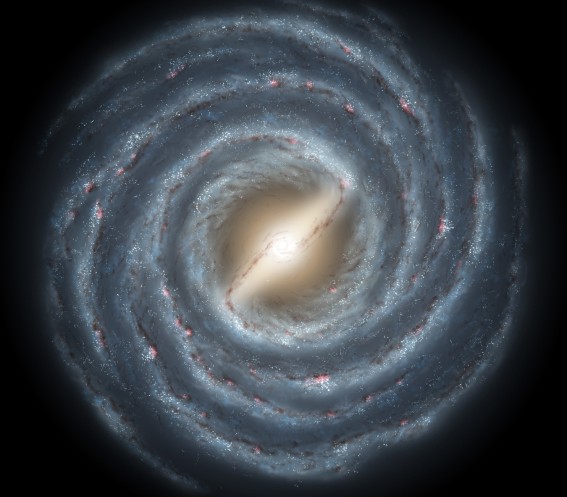







| BOOKS | F. A. Q. | ARTICLES | TALKS | ABOUT KEN | ORDER BOOKS | BEYOND OUR KEN |
|---|
By Ken Croswell
Published on ScientificAmerican.com (December 3, 2012)

Great Galaxy: The Milky Way maintains a fleet of some two dozen satellite galaxies whose motions help reveal its mass. Credit: NASA/JPL-Caltech. Art by Robert Hurt.
Although scientists know the masses of the Sun and Earth, it's a different story for the Galaxy. Mass estimates range widely: at the low end, some studies find that the Galaxy is several hundred billion times as massive as the Sun, whereas the largest values exceed 2 trillion solar masses. Astronomers would have an easier task if the Galaxy consisted solely of stars. But a huge halo of dark matter engulfs its starry disk and vastly outweighs it. Now remarkable observations of a small galaxy orbiting our own have led to a new number.
In studies of the Milky Way's mass, one little galaxy plays an outsize role: Leo I. "The value of Leo I is twofold," says Michael Boylan-Kolchin of the University of California, Irvine. "It's both very distant and moving quite quickly." Discovered in 1950 and located 850,000 light-years from the Milky Way's center, Leo I is a dwarf spheroidal galaxy and the farthest of the many galaxies that are thought to orbit our own. Most of the Milky Way's dark matter halo should fit inside Leo I's orbit—that is, if the dwarf galaxy is actually in orbit and not just passing by.
Astronomers know from Leo I's Doppler shift that it is racing away from us. If the Milky Way has enough mass, its gravity will hold it in orbit. Moreover, astronomers would be able to observe the motion of Leo I and use it to deduce the Milky Way's total mass—including its dark matter halo—out to the dwarf galaxy's great distance. But if the Milky Way does not have enough mass, Leo I will fly away, its high speed revealing little of consequence.
To deduce Leo I's path through space, astronomers have to determine the small galaxy's precise motion. The Doppler shift reveals Leo I's velocity along our line of sight, but no one knew how fast the little galaxy was moving across it. Determining that requires measuring its proper motion—the change in the galaxy's position from one year to the next. Proper motion is easy to gauge for a nearby star but difficult to measure for another galaxy, because far-off objects have tiny proper motions.
Sangmo Tony Sohn of the Space Telescope Science Institute and his colleagues therefore used the Hubble Space Telescope to compare Leo I's position in 2006 and 2011 with more than a hundred background galaxies. In work submitted to The Astrophysical Journal, Sohn's team reports success: the first proper motion measurement of Leo I.
"It's a powerful piece of work," says Timothy Beers, the director of Kitt Peak National Observatory, who was not affiliated with the research. "It strikes me as utterly amazing that we have instruments that can measure proper motions that far away." Scott Tremaine, an astronomer at the Institute for Advanced Study, agrees: "The measurement of the proper motion really is a tour de force."
Combined with the Doppler shift, the proper motion reveals that Leo I orbits the Milky Way at 200 kilometers per second. By comparison, that's nearly as fast as the Sun orbits the Milky Way's center, even though the dwarf galaxy is much farther away. Says Boylan-Kolchin, "To sustain a similar velocity at that far a distance requires a lot of extra mass."
How much mass? In a companion study, Boylan-Kolchin and his colleagues simulate how giant galaxies such as the Milky Way grow by swallowing lesser galaxies, finding that dwarf galaxies moving as fast as Leo I are almost always bound to the giants, which means Leo I is a true satellite. His team then derives a mass for the Milky Way of 1.6 trillion suns. "That's on the high side," Beers comments. "But it's not outrageous."
Boylan-Kolchin says there's a 90 percent chance that the Milky Way is between 1.0 trillion and 2.4 trillion times as massive as the Sun. He hopes Hubble will provide precise proper motions of two other distant satellite galaxies—Leo II and Canes Venatici I—as well as Leo T, a galaxy even farther than Leo I that does not yet orbit the Milky Way but is falling toward it. Then he thinks he can cut the uncertainty in the Milky Way's mass drastically.
Our Galaxy's exact mass has implications throughout the universe. "The Milky Way is the keystone in understanding more distant galaxies," Boylan-Kolchin says. "Therefore, getting a good mass for the Milky Way is very important for modeling the Milky Way and other galaxies."
Lest the new work fill Milky Way residents with excessive pride, Beers says, "We're still number two." Of the several dozen galaxies that populate the Local Group, the largest remains Andromeda, which Beers estimates is at least twice as massive as the Milky Way. Still, most new Local Group stars are made right here in the Milky Way rather than in its larger neighbor.
Ken Croswell is an astronomer and the author of Magnificent Universe and The Lives of Stars.
"Magnificent Universe by Ken Croswell is elegant and eloquent."--Washington Post. See all reviews of Magnificent Universe here.
"A stellar picture of what we know or guess about those distant lights."--Kirkus. See all reviews of The Lives of Stars here.
| BOOKS | F. A. Q. | ARTICLES | TALKS | ABOUT KEN | ORDER BOOKS | BEYOND OUR KEN |
|---|